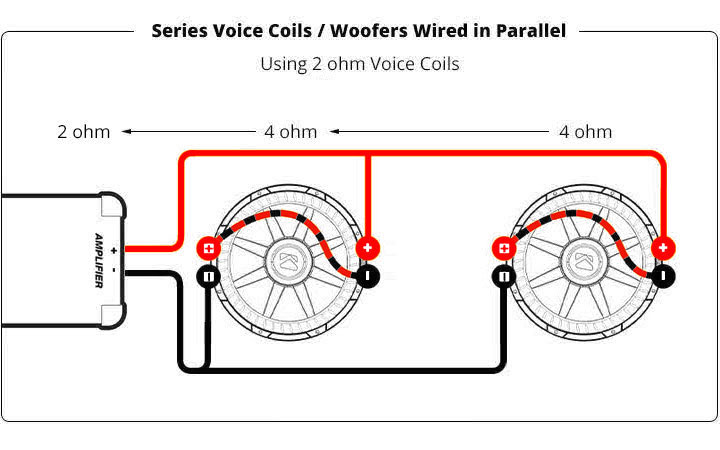Unlocking Subwoofer Power Achieving a 1 Ohm Load

Ever wondered how to squeeze every last drop of bass from your car's sound system? For those chasing the deepest rumble, achieving a 1-ohm load with dual subwoofers can be the key. Imagine harnessing the combined power of two 2-ohm subwoofers, orchestrated to deliver a symphony of low-frequency goodness. This article dives deep into the world of subwoofer wiring, exploring the hows, whys, and potential pitfalls of achieving that coveted 1-ohm impedance.
Connecting two 2-ohm subwoofers to achieve a 1-ohm final impedance involves specific wiring configurations, primarily parallel wiring. But before you grab your speaker wire and start connecting, understanding the implications for your amplifier and subwoofers is crucial. A mismatch between the amplifier's capabilities and the subwoofer load can lead to overheating, damage, and ultimately, a silent system.
The quest for lower impedance stems from the relationship between impedance, voltage, and power. Lowering the impedance increases the current draw from the amplifier, which in turn, can increase the power output. This means more power to drive those subwoofers, resulting in a more intense bass experience. However, not all amplifiers are designed to handle such low impedance loads. This is where careful planning and matching of components become paramount.
The history of subwoofer wiring is intertwined with the evolution of car audio systems. As enthusiasts pushed the boundaries of bass performance, techniques for achieving lower impedance loads emerged. Initially, this involved complex wiring schemes and custom-built subwoofers. Today, readily available dual voice coil subwoofers simplify the process, allowing for a 1-ohm load with relative ease.
Achieving a 1-ohm load with two 2-ohm subwoofers requires wiring them in parallel. This involves connecting the positive terminals of both subwoofers together and the negative terminals together. This configuration effectively halves the total impedance, resulting in a 1-ohm load. However, it's important to consult the specifications of both your amplifier and subwoofers to ensure compatibility.
One benefit of wiring for a 1-ohm load is maximizing power output from a compatible amplifier. More power means louder and more impactful bass. Another advantage is increased efficiency in power delivery. With less resistance, the amplifier can deliver power more effectively to the subwoofers. Finally, achieving a 1-ohm load can allow for greater flexibility in subwoofer selection and system design, particularly in multi-subwoofer setups.
Advantages and Disadvantages of 1-Ohm Wiring
| Advantages | Disadvantages |
|---|---|
| Maximized Power Output | Risk of Amplifier Damage |
| Increased Efficiency | Voiding Warranty |
| System Design Flexibility | Increased Heat Generation |
Best Practices:
1. Verify Amplifier Compatibility: Check your amplifier's specifications to ensure it can handle a 1-ohm load.
2. Use High-Quality Wiring: Use thick gauge speaker wire to handle the increased current draw.
3. Proper Grounding: Ensure a solid ground connection to prevent noise and interference.
4. Monitor Amplifier Temperature: Keep an eye on your amplifier's temperature to avoid overheating.
5. Start Low and Increase Gradually: Gradually increase the volume to avoid sudden surges in power.
FAQ:
1. Can any amplifier handle a 1-ohm load? No, not all amplifiers are designed for such low impedance.
2. Is wiring to 1-ohm always better? Not necessarily. It depends on the amplifier and subwoofer compatibility.
3. What happens if I wire a 1-ohm load to an incompatible amplifier? You risk damaging the amplifier.
4. How do I check my amplifier's impedance rating? Consult the amplifier's manual or manufacturer's website.
5. Can I wire two 4-ohm subwoofers to 1 ohm? No, wiring two 4-ohm subs in parallel results in a 2-ohm load.
6. What gauge wire should I use for a 1-ohm load? Thicker gauge wire, like 8 or 4 gauge, is recommended.
7. How can I tell if my amplifier is overheating? It may feel hot to the touch, or the sound may become distorted.
8. What's the difference between parallel and series wiring? Parallel wiring lowers impedance, while series wiring increases it.
Achieving a 1-ohm subwoofer load can unlock a new level of bass performance in your car audio system. By carefully considering amplifier compatibility, using high-quality wiring, and following best practices, you can safely and effectively harness the full potential of your subwoofers. However, remember that improper wiring can lead to damage and disappointment. Always consult your amplifier and subwoofer specifications and consider seeking professional advice if needed. The reward of a powerful, thumping bass experience is well worth the effort of careful planning and execution. Upgrade your listening experience, feel the bass, and enjoy the journey into the world of low-frequency audio bliss!
The contemplative angler a journey into fly fishing gear acquisition
Unveiling charizard what type is this iconic pokemon
Decoding the chevy 1500 6 lug bolt pattern a deep dive












